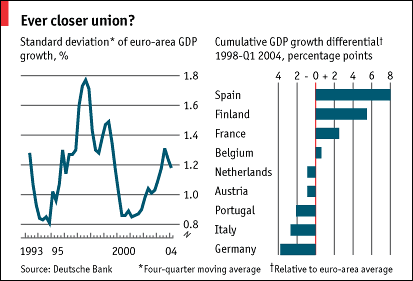
AS IT approaches its sixth birthday, a steady flow of reports has appeared, grading Europe's single currency on its performance. The Organisation for Economic Co-operation and Development, the International Monetary Fund and the European Commission have all weighed in. The commission, predictably, sees the euro as a success, albeit a qualified one. Inflation, it notes, has been low and stable. Growth has not been brilliant, but the currency has at least defied the gloomiest forecasts of economic instability—a minimal requirement, you might suppose. The switch to new notes and coins at the start of 2002 went more smoothly than expected.
The main economic purpose of the single currency is to deepen integration among its members, by reducing the costs of cross-border commerce. Along with freer movement of labour and capital, the common coin might in turn make business cycles in different euro-zone countries more aligned. Indeed, this was one argument in support of the single currency in the 1990s; opponents worried about whether cycles were sufficiently in tune for the thing to work. It is early days, but the commission thinks that such cyclical convergence is slowly happening.
On this point, economists from two German banks have doubts. First, a team from Deutsche Bank argues that Europe's economies are now marching, as much as ever, to the beats of their own individual drums. Take the second quarter of this year: real GDP grew by a healthy 3%-plus, at an annualised rate, in France, but shrank by 0.8% in the Netherlands.
How does that compare with the days before the euro? The authors computed the standard deviation—a measure of how far each country's figures stray from the average—of quarterly economic growth rates over the past decade for the nine countries that publish quarterly figures (see the left-hand side of the chart below). A rising standard deviation implies that economies are diverging; a shrinking figure, that they are coming together. Although there is evidence of convergence between 1999 and 2001, since then individual countries have gone their separate ways.
 |
Over time, the effects build up (see right-hand chart). The most striking difference is between Spain, whose economy has grown by 18.7% since 1999, around eight percentage points more than that of the euro area as a whole, and Germany, whose GDP has expanded by only 7%. To some extent, it might have been expected that Spanish standards of living would rise towards German levels. But France has also outstripped Germany, even though its GDP per head is similar. Euro-area countries seem to be out of sync with each other.
The divergence in the growth rates of euro members conceals much larger, and widening, differences in the components of economic growth: changes in consumption, investment, government spending and net exports. Take consumption, the biggest element. Between 1998 and the first quarter of this year, consumer demand was buoyant in Spain, France and Finland, but flaccid in Germany, Italy and the Netherlands. The standard deviation of consumption growth has doubled since 2001 and is now higher than it was in 1999. In investment, the differences are even more striking. Capital spending in Germany fell by 6.3% during the period, while in Spain it rose by 26.3%. The investment gap widened markedly in 2003. In trade, there is a similar story: Italy's export growth has been weak, while German and Austrian exporters have done far better than the average for the euro area.
David Owen, of Dresdner Kleinwort Wasserstein, takes a slightly different view. He argues that the divergence of real GDP in the euro area's four biggest economies—Germany, France, Italy and Spain—has been tamed since the euro's birth. Indeed, these economies became increasingly in sync during the economic upturn in 2000, a phase when growth rates are even more likely to go their separate ways. But he also points to the divergence of consumption, investment and (especially) exports in recent years. He ascribes this in part to differences in real exchange rates: although nominal exchange rates are fixed, differences in inflation across countries can still affect real exchange rates. Germany's low inflation, for example, has made the country's exports relatively cheap.
Furthermore, inflation rates, as measured by GDP deflators, have diverged. As a result, nominal growth rates—the sum of real GDP growth and inflation—have also diverged. Mr Owen surmises that this may have knock-on effects on European stockmarkets. Because stockmarkets tend to focus on nominal variables, such as profits, they may come to depend more, not less, on nationality.
Why the continued divergence? Perhaps it is simply too early to expect much to have changed. But the Deutsche Bank economists speculate that, despite efforts to converge in advance via product markets, services and financial markets, countries entered the single currency from very different starting points. Once in the euro, these differences paved the way for increasing divergence in real growth. Europe's single interest rate has helped to widen the gap: monetary policy has been too tight for sluggish Germany, for example, holding down its growth and inflation rates, and too slack for faster-growing countries. They finger the usual suspects. Labour-market rigidities aggravate real divergence, by failing to allow wages to adjust to local circumstances. Inflexible fiscal policies, in part the result of efforts to comply with the stability and growth pact, have needlessly deepened recessions.
Even so, it is hard to say how much divergence is too much. Different parts of America, itself a single-currency area, grow at different rates, and no one doubts the future of the dollar. America, though, has the labour-market flexibility and fiscal mechanisms that help to make a single-currency zone work fairly smoothly. These, however, Europe lacks.